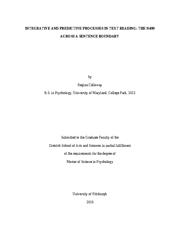A copy of this work was available on the public web and has been preserved in the Wayback Machine. The capture dates from 2018; you can also visit the original URL.
The file type is application/pdf.
Integrative and predictive processes in text reading: the N400 across a sentence boundary
2017
Language, Cognition and Neuroscience
iv In the present study we used two experiments to test whether readers use integrative (retrospective), predictive (prospective), or both processes when reading words across a sentence boundary. We used Experiment 1 to determine whether prediction and integration could be measured as distinct processes. Response times (RTs) to determining whether probe words occurred in a previous sentence were measured. Critical probes were either high or low predictable words, given a context sentence. Both
doi:10.1080/23273798.2017.1279340
fatcat:qsozjmdkmrg7zdawm7fw6yoapu

